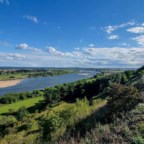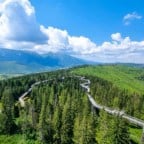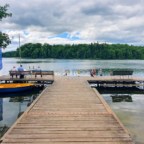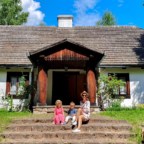Are you planning a weekend in Vienna? We present you with an interesting idea, a plan for the weekend. Here you will find a list of places that answers the question what is a must see in Vienna? …although the list seems endless ;-)
We were in Vienna in early November. While most Poles bravely glided through the clogged streets and searched for at least a scrap of space to park under the cemetery, we savored Vienna’s architecture illuminated by the autumn sun. We deliberately escaped from Poland to this European capital to take advantage of the extended weekend and spend more than just 2 days in Vienna.
Even though we were there for a full four days, we still feel that we only saw the top of the iceberg, but the most beautiful part of it. The number of sights and places of interest in Vienna will knock your socks off, and it’s hard to pick just a few of the most interesting places.
We tried to see as much as possible and make the most of our time on the site, but traveling with a child has it that the plan has to be changed often and child attractions come to the fore. We also make no secret of the fact that we focus on the quality of travel and not just quantity, so instead of rushing from one object to another, we prefer to look inside, see the interiors, learn something interesting, or at least feel the atmosphere of the place.
Table of contents
What is worth seeing in Vienna?
In Vienna, this is especially important, because a glimpse, just from the outside, is definitely not enough. Here you will find galleries, museums, palaces whose collections are so impressive that a few days will not be enough. Of interest: the city has 120 concert halls and theaters (including 4 opera houses), more than 100 museums, 27 palaces, 280 gardens and parks. It’s impressive, isn’t it? Vienna has always attracted artists. Among others, they were born or lived here. Schubert, Strauss, Mozart, Beethoven, Haydn.
Vienna is always worth coming to. No matter what time of year you choose. We were in autumn and the złbrown colors looked insane (especially in Prater Park). We witnessed the laying out of the Christmas market, the setting up of the Christmas tree in front of Schönbrunn Palace, and we are convinced that the Christmas atmosphere here is fabulous. In 2018, Vienna will celebrate the year of modernism and the four main protagonists of the era , who died in 1918: Gustav Klimt, Egon Schiele (painters), Otto Wagner (architect) and Koloman Moser (artist). They are not widely known in Poland, but their work and that of other artists at the turn of the century made Vienna one of the most important intellectual and cultural centers in Europe. As a result, you can expect many interesting exhibitions and thematic eventszłyear (more info here).
In Vienna, getting your bearings shouldn’t give you much trouble, and the most interesting sites are located close together (although you have to drive to Schönbrunn). The most important buildings in the city are located on the boulevard built by order of Emperor Franz Joseph I – Ringstraße, which is 5.3 kilometers long.
We present below a list of places that we managed to see and are worth recommending. Unfortunately, we were not able to go inside everywhere, but as they say: there will be something to come back for :)
Old Town
As a rule, the first steps are directed towards the old historic city with the hope of finding real gems there. This is not difficult to find in Vienna. As soon as we entered the area of the old city (Innere Stadt), we immediately felt like we were entering another world. On the one hand, café upon café, restaurants, souvenir stores, a river of tourists, and on the other, horses pulling carriages, gentlemen in stylish robes wanting to invite you to concerts and, most importantly, beautiful architecture.
It was quiet at first, as we were around 9 a.m., but as the day progressed, more and more people appeared on the sidewalks and promenades, and it became a challenge to walk with a stroller. Fortunately, some of the roads are off-limits to motorized traffic and fully dedicated to pedestrians.
The historic old town is a UNESCO World Heritage Site. Vienna’s most famous monuments are located here, such as. Cathedral of St. Stephen, the Hofburg, museums, galleries, churches and other sites we write about later in the post, but here we wanted to highlight simply the old town itself.
Baroque architecture dominates the streets, and while it can be hard to look at the fronts of the townhouses because you have to focus on paving your way, it’s worth stopping every now and then to look up at the richly decorated buildings. Time can also be made more enjoyable by the numerous cafes, which encourage you to stop for a while and observe the life of the Austrian capital from the sidelines.
The Cathedral of St. Stephen
A symbol of Vienna and even all of Austria, it is fondly called “Steffl” by Autriacs. The construction of St. Peter’s Cathedral. St. Stephen’s Cathedral began in the 14th century and today the cathedral is considered one of the most beautiful Gothic religious buildings in Europe.
Standing on Stephansplatz, one’s eyes are immediately drawn to the 136-meter high tower and the cathedral’s roof, which is covered with 230,000 tiles that are arranged in shapes: the Habsburg eagle, the coat of arms of Vienna and Austria. The north tower houses Austria’s largest bell (Pummerin).
The cathedral is partially under renovation. You can go inside (for free), but you can’t walk freely during mass (which is perfectly understandable). Inside, the marble sarcophagus of Emperor Frederick III Hohenzollern is particularly noteworthy.
The place is full of life, with groups of tours clustering around the cathedral, carriages and horses can be heard in the distance, and dignified gentlemen dressed in clothes trying to sell concert tickets. Attention! These are not concert tickets at the famous Viennese opera house.
Hofburg Palace
The Hofburg is the palace where Austrian rulers officiated for more than 700 years. Do not equate the term palace with a single building here, because the Hofburg is an impressive palace complex consisting of several buildings, courtyards, gates and monuments.
Please define valid width and height attributes for remote images. This will also optimize the loading time of the remote panorama.At first we walked a little lost between courtyards trying to find our way around this small city within a city, fortunately, almost at every turn we can find maps and signposts to the different parts. The weather was excellent and we were able to spend a lot of time simply walking around the former Habsburg domain and the current seat of the president.
Please define valid width and height attributes for remote images. This will also optimize the loading time of the remote panorama.There are so many interiors to see here that one could spend a whole day on the Hofburg and still we are not convinced that we would manage to see everything with due diligence. Tours include the Sisi Museum, the imperial apartments and the silver collections. Inside, there are many personal items of Empress Elisabeth (known as Sisi or Sissi), including clothes, accessories, and you can see what the daily life of the emperor and empress was like, what hobbies they had and the empress’s beauty secrets.
Please define valid width and height attributes for remote images. This will also optimize the loading time of the remote panorama.As in many such places, the Hofburg also had to make room for a
The Imperial Treasury, where the most exquisite treasures and insignia await visitors, including. The crown of the Austrian Empire, the crown of the Holy Roman Empire or the jewelry of Empress Elisabeth.
We recommend something less well-known – State Hall, the National Library built in the 18th century. It is one of the most beautiful historic libraries in the world. We were intrigued by the pictures of the library, the bookcases full of books and the baroque interiors – all of which made us decide to take a look inside.
Almost 80 meters long, 14 meters wide and almost 20 meters high, the hall houses some 200,000 books dating from 1501 to 1850. In addition to the books, there are marble sculptures, globes (one depicting the earth and the other the sky) and frescoes that made us marvel not at the collections but at the whole environment of the place.
There is one place in the palace that is unique in the world – it is the Spanish Court Riding School (Spanische Hofreitschule). The only place of its kind where you can see equestrianism in an old way, or even very old, as it dates back 450 years. The shows are held in an 18th century baroque hall. The training and performance calendar can be found here.
MuseumsQuartier
MuseumsQuartier (MQ), translated as Museum Quarter or Museum District. It is one of the largest complexes related to art and culture in the world, with an area of 60,000 square meters! Historically, there was a chicken farm on the site, and then a stable for 600 horses and 200 carriages, until the first part of the MQ finally opened here in the late 1990s.
Within the MQ are, among others: Leopold Museum, mumok (Museum of Modern and Contemporary Art), Art Hall, and (and perhaps most importantly) the Zoom Children’s Museum.
Yes, it is because of the last position that we came to this area. ZOOM Museum is a fantastic place for children (almost) of all ages. Almost, because the entry has been for 8 months which is rare anyway. This means that even non-walking children will find something to enjoy here. So what does a children’s museum look like? It is more of an educational, cognitive, discovery center where toddlers explore the world and learn through their various senses. We were in the part for the youngest – Ocean, which can be entered by parents with children (parents paid, child for free, but do not think that they will let you leave your child alone ;) ).
The storied room is styled as an ocean floor, a ship, a submarine, a piece of land and more. Children can touch, check, push, climb, slide, roll over…. do almost anything! We were exhausted after a few minutes, Olive on the contrary :)
Older children can take part in creative, artistic and multimedia activities. There is something for everyone and we can already promise that we will return to this place again!
The MQ also features restaurants, cafes, festivals and even concerts.
Museum of Natural History and Museum of Art History
We took further steps to Maria-Theresien-Platz, where there are two, large buildings with museums: the Natural History and Art History.
Initially, we didn’t plan to go inside, but since we were in the area and had time before the ZOOM Children’s Museum at MQ, we decided to take advantage and went inside the Natural History Museum. There are two floors of exhibits showing nature, including various organisms, from the simplest tozł, minerals, dinosaurs. There are also prehistoric tools, meteorites or a digital planetarium.
At first we were not convinced, but as soon as we saw Olive running from exhibit to exhibit we understood that even the youngest children can have a lot of fun from a visit to this museum.
We were most impressed by the allosaurus in the dinosaur room, which moved and made sounds (which scared a few children) and the part about our ancestors (very realistic reproduction!).
The museum also has temporary exhibitions – during our stay it was just about dogs and cats.
Opposite the Museum of Natural History is a real treat (another one already) for those interested in art – the Museum of Art History. We, on average, are familiar with art, but we realize how important works are here. The museum is famous for the world’s largest collection of Bruegel paintings. Here you can find works by such famous artists as Dürer, Raphael, Titian, Velázquez and many others, from ancient times to the modern era.
Vienna Opera House
Many people who come to Vienna necessarily want to see the Vienna Opera House. However, it is one thing to see a building, another to go inside, and quite another to go to a performance.
Unfortunately, to see it from the outside is just to see another building in Vienna. You can go inside with a guide – during the 40-minute walk you can see places that the public does not have access to on a daily basis, learn about the history of the place and some interesting facts. Unfortunately, it can be difficult to get such a tour, as they do not take place every day and at every full hour. To avoid kissing the doorknob, it’s worth checking before you arrive when guided tours are possible here.
Albertina Gallery
Right next to the opera house is the Albertina Gallery. It was founded in 1768, in the palace where the Habsburgs lived.
The gallery’s holdings are impressive, and the gallery itself is one of the largest collections of prints in the world, including 50,000 drawings and watercolors and 900,000 prints! It includes works by, among others. Monet, Renoir, Beckmann, Rothko, Dürer, Rubens, Klimt, Kokoschka, Rauschenberg, Picasso and many, many others (some in temporary exhibitions). Inside, you can also enjoy the rooms, including 21 restored apartments.
Butterfly House
The Butterfly House (Schmetterlinghaus) at the Palm House is a place where butterflies can fly freely in an arranged tropical forest, with waterfalls and bridges. It is a place where you can feel like you are in the forest, walking among the trees and bushes watching and hunting with your camera for these gentle creatures. The butterfly house houses about 400 butterflies.
An attraction for older children and adults rather than toddlers who have barely started walking ;)
House of Music
The House of Music(Haus der Musik) is another place in the center where you can interact with art but in a slightly different way. The building is located off the beaten path, not on the main tourist routes, and you can see from the very entrance that this is not a place that everyone visits. There are no queues at the cash registers, and the fact that someone is inside is evidenced by the baby carriages left at the bottom.
Inside is an interactive museum where one enters the world of sounds, music, instruments, composers. Great entertainment for older children (5+ or so), where you can play giant instruments, conduct an orchestra, and learn how sounds are created.
Vienna City Hall
The city hall building is a bit far from the strict old town, but it is worth the short walk. We walked along the ring from the Natural History Museum, passing the Parliament building on the way.
When we approached the park located right next to the city hall, our eyes were met by workers laying wooden track, stalls and fences. At first we didn’t know what they were preparing, but we quickly realized that November is when the Christmas markets start in Vienna, so work is already underway to get all the infrastructure ready. However, this did not prevent us from taking a short break in the park. The work was not noisy, and we also found a free bench without any problems. It was surprising that we were sitting in the center of a large city, and we didn’t hear cars, people weren’t dodging like in a hurry, and there were only strollers around.
The Town Hall (Wiener Rathaus) immediately brought to mind the Westminster buildings in London. Built in the second half of the 19th century, this neo-Gothic building is the seat of the mayor and city council.
Park Prater
Prater Park (Wiener Prater) is located on the other side of the Danube Canal. It is both a public park and a funfair, especially close to us (literally!), as we stayed at the magdas hotel, which is right next to the park, during our stay in Vienna. In the mornings and evenings, we could watch the park come to life, the Ferris wheel slowly churning, and the more chilling attractions releasing screams from the throats of people who still pay for such attractions.
In the mornings, as we walked to the nearest metro station, we would pass Viennese people who went to the park for a morning jog, and when we returned in the evenings we would see whole families hanging out together or groups of people who prefer a louder atmosphere and headed to the amusement park.
There are about 250 attractions (!!!) in the Prater funfair for children of all ages as well as adults. Entrance to the amusement park is free, but you pay separately (a few euros) for each attraction. Here you’ll find slow carousels, choo-choo’s, self-propelled cars, Ferris wheels (including the famous 65-meter tall Ferris wheel ), rollercoasters (including an indoor train!), a scare house, a 177-meter high (!) carousel, slot machines, restaurants, cafes, and even a wax figure museum (Madame Tussauds) or a chocolate museum!
In the evenings, the place turns into a veritable parade of lights, sounds and music. We were concerned that the amusement park closes in November, but most of the attractions were open. Although it gets dark early, a lot of people come here, but there are neither crowds nor queues for the attractions. It is peaceful and safe so that even late at night we were not afraid to come here with a child.
Prater is also a leisure and recreational park, where you can walk, run, bike, but also use the infrastructure for skateboarding, rollerblading, playgrounds, etc. The place looked simply fabulous in autumn, and if it weren’t for the fact that we were limited by time, we could have spent half a day in the park.
Schönbrunn
Finally, we left a gem. The Habsburg summer residence Schönbrunn (Schloss Schönbrunn) is a sprawling complex that includes a palace, park, zoo, orangery, private gardens, palm house, greenhouse, labyrinth, fountain and even a swimming pool. We will describe the site in detail in a separate post, but it must also be mentioned here. The Habsburg residence is not in the center of Vienna, but it can be reached by subway, and the trip from the center takes about 20 minutes.
We started our tour of the complex with the zoo, and then moved on to the park and the palace. The zoo located here (Tiergarten Schönbrunn) is the oldest operating zoo in the world. More than 700 species of animals await small and larger explorers here, including the most famous giant panda. Even though the garden is considered one of the best in Europe, we still felt that the animal enclosures were too small.
From the zoo we walked out to the park area, where at one end you can see the monumental palace, and at the other end you can see the fountain and the Gloriette rising above it, overlooking the park area and the palace.
The palace is another example of Baroque architecture in Vienna. The interiors are available for guided tours with an audio guide or as part of guided groups, although you have to admit that it is complicated to embrace all the available packages :) You can buy single tickets, family tickets, for different parts of the palace, taking into account the labyrinth, the private gardens, the orangery…. of course, you can purchase a separate ticket for each of these places. We took the Grand Tour package, which includes viewing 40 chambers (out of a total of 1,441!), including the Emperor’s and Empress’s apartments, the Chinese Cabinet, the Grand Gallery, and the Hall of Ceremonies.
The palace also has a separate, special museum for the youngest, where they can learn about the life of children in the palace, how they dressed, what they did, how they had to behave. An attraction rather for children older than Olive :)
In addition to the garden, it can be a lot of fun to enter the labyrinth, with an area of 1,700 square meters. Above the maze there is a platform from which strays can be observed. Other points of interest include the palm house, which houses more than 4,000 species of plants and is one of the largest palm houses in Europe, and, on the other side, the greenhouse, a desert house where desert animals and plants officiate(Wüstenhaus).
The Habsburg Summer Residence is on the UNESCO World Heritage List (it’s hard to count how many sites in Vienna are on this list :) ).
You can read more about Schönbrunn Palace and the Vienna Zoo here.
Map of Vienna attractions
Finally, here is a map with all the above-described attractions of Vienna, which are worth seeing during a weekend getaway :)
Summary
If you have reached this point, first of all, thank you and at the same time we hope that we do not need any more convincing to come to Vienna :)
We were enchanted and delighted by Vienna. We are the best example of how people who are not necessarily familiar with art will be absorbed by it here. This doesn’t just mean visiting museums and galleries with works of art, but simply seeing the city, the architecture, impressive palaces, spending time in parks and gardens.
At the same time, this was our first trip where we saw so many attractions for children, and I think we got really into it :)
We highly recommend this direction, especially since thanks to the new roads, Vienna has become even closer to us Poles.
We also invite you to a gallery with 150 photos from Vienna:











































































